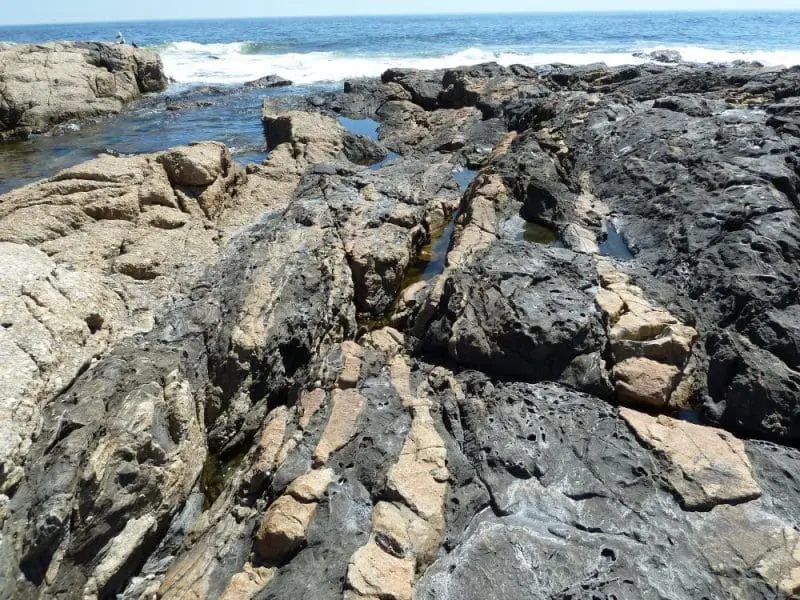[Originally published as Famous contact at Sea Point, South Africa, reveals rapid granite emplacement]
On the shore at Sea Point, south of Cape Town, sits a dramatic geological contact (see image above) that has been famous for over two centuries. This complex and spectacular feature was first described by Clark Abel in 1818,1 and then visited by the young Charles Darwin in 1836, on his journey around the world on HMS Beagle.2
It is at this point that once-molten magma intruded the sediments of the Malmsbury Group, believed to have occurred at a depth of some 10 km.2 We now observe the results of this event frozen before our eyes, a complex intermixing of the dark sedimentary rocks with the pink-brown igneous granite.
Heat from the intruding granite has altered the Malmsbury sediments, turning them into hornfels. The zone of alteration is called a contact aureole and extends for at least 100 metres from the contact.3
The contact between the two rocks consists of a complex of interlocking, intermixing shapes, like intertwining tongues or flames (figure 2). The molten granite looks like it has been swirled and sheared with the sediments, like the mixing of two different coloured cake mixtures in a bowl.

Such long swirls of granite are what we would expect from a pool of magma intruding the sediment while the magma was molten, plastic, and easily deformed. However, the intertwining shapes of the dark sediments at the contact are almost as intermixed, suggesting that they also were plastic, to a certain extent, at the time of the intrusion. Does this mean that there was not much time between the deposition of the sediments and the intrusion of the granite?
It has long been considered that granite plutons took vast periods of time to form. The thinking has been that enormous ‘balloons’ of magma, 10 km or more in diameter, accumulated gradually deep inside the crust and rose slowly to the surface over millions of years. Imagine a balloon of oil rising through a pool of water. However, the analogy breaks down because the molten granite is said to have risen, as a single towering body, through solid rock.
Recent papers in the Proceedings of the Geologists’ Association in the UK revealed that geologists specializing in granite abandoned the balloon idea long ago.4 The lead researcher, John Clemens, said, “In fact, just about everything that was taught as recently as ten years ago about granitic magmatism has been turned on its head.”5 Another researcher, W.J. Pitcher, who has studied granites for 60 years, said he has long considered the idea of a single towering body of magma “an offence to reason.”6
Instead, he and the other researchers consider that the magma rose through long cracks and fissures in the crust, forming dykes, which were only a meter or so wide. Some estimates for the ascent time of some of the larger magma pools are as low as five hours.7 After ascending in the fissures, the magma pooled in a large tabular pluton, as opposed to a towering body, closer to the surface.
It seems that whenever we encounter folded and deformed sediments in the field, we find intrusions of granite. I suspect it was the crustal movements that caused the deformation and folding that also generated the granite magma and caused it to move through the crust.
The contact at Sea Point, South Africa, appears consistent with the new thinking that granite formation was rapid. Indeed, as granite researchers have found, granite emplacement is catastrophic in its suddenness.
References and Notes
1. Theron, J.N., Gresse, P.G., Siegfried, H.P. and Rogers, J., The Geology of the Cape Town Area, Department of Mineral and Energy Affairs, Republic of South Africa, p. 60, 1992.
2. Compton, J.S., The Rocks and Mountains of Cape Town, Double Storey Books, p. 52, 2004.
3. Theron, et al., ref. 1, p. 62.
4. Clemens, J.D., Granites and granitic magmas: strange phenomena and new perspectives on some old problems, Proc. Geologists’ Assoc. 116:9–16, 2005; p. 15.
5. Clemens, ref. 4, p. 15.
6. Pitcher, W.S., Invited comment on Clemens’s ‘Granites and granitic magmas’, Proc. Geologists’ Assoc. 116:21–23, 2005; p. 21.
7. Clemens, ref. 4, p. 14.
Further reading
Compton, J.S., The Rocks and Mountains of Cape Town, Double Storey Books, 112 pp., 2004.
Theron, J.N., Gresse, P.G., Siegfried, H.P. and Rogers, J., The Geology of the Cape Town Area, Department of Mineral and Energy Affairs, Republic of South Africa, 140 pp,. 1992.
McCarthy, T. and Rubidge, B., The Story of Earth and Life: A Southern African Perspective, Struik Nature, Cape Town, 334 pp., 2005.






